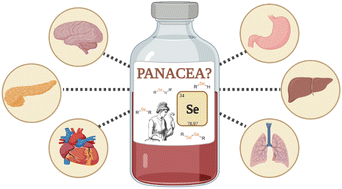Organic selenocompounds: are they the panacea for human illnesses?
Abstract
The selenium element is essential to some life forms and its biological-chemistry function is mainly performed by the selenol/selenolate moiety (–SeH/–Se–) in a few selenoproteins. Many synthetic organoselenium compounds (OSeCs) have demonstrated important therapeutic applications, with the Ebselen and diphenyl diselenide being the most studied OSeCs. They could act as “hidden selenol” molecules, where the –SeH/–Se– are responsible for the reduction of dangerous peroxides and the protection against the neurotoxic methylmercury. However, their actual mechanisms of action at atomic/molecular level are still elusive. The main conundrum about OSeCs is how they can have quite different structures and similar in vivo action and at the same time modulate quite distinct physiological functions? The question is a hard one because we know little about the metabolism of OSeCs, the in vivo studies are always typically phenomenological, OSeCs have low selectivity and non-specific interactions with thiol-containing proteins. The use of in silico and in vitro models, followed by new analytical methodologies, will give important answers about the metabolism, reactivity, and specificity of OSeCs with specific biological targets, and a real advancement in the subfield of “pharmacological applications” of OSeCs.

- This article is part of the themed collections: 2023 Focus and Perspective articles and 50th anniversary of ICCST: celebrating ICCST at its 15th Edition


 Please wait while we load your content...
Please wait while we load your content...